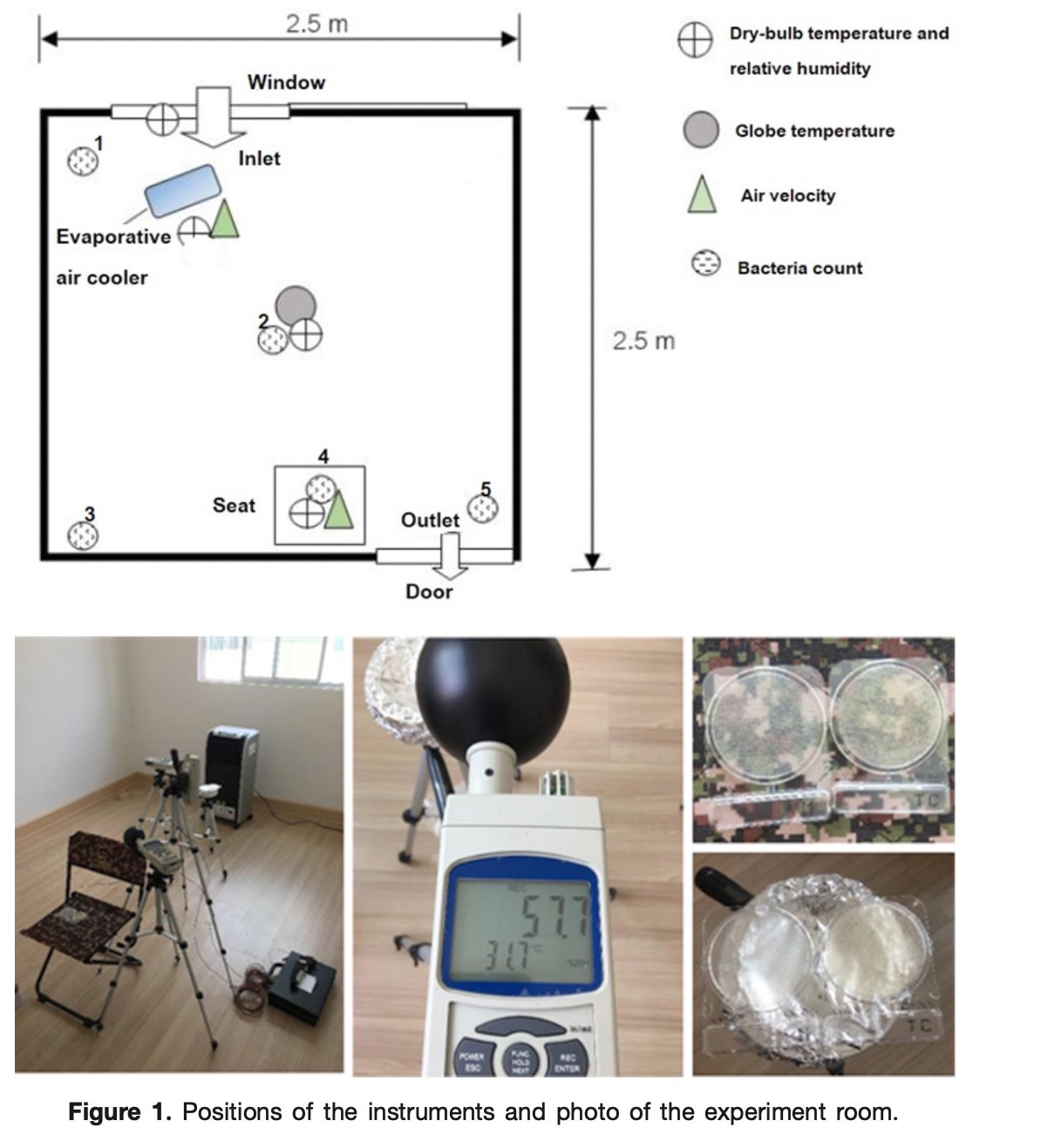Evaluation of Human Thermal Comfort and Microbial Analysis in an Evaporative Cooling Room
Main Article Content
Abstract
In Thailand, evaporative air coolers (EAC) are common in outdoor and semi-outdoor areas. Exploring the possibility of using an EAC in an indoor area, this research aims to determine its benefits in a natural, ventilated room during summer and winter. In terms of human thermal comfort, these benefits are evaluated through the CBE Thermal Comfort Tool with environmental parameters collected from the testing room. Bacterial growth due to increased humidity is analyzed based on bacterial counts in the opened Petri dishes. The results from the testing room with EAC show that air temperature reduces by 1.4 - 4.4 °C during winter and 3.3 - 3.5 °C during summer with a relative humidity increase of 2.3 - 13.1%. Thermal comfort was found to depend on indoor air temperature and air velocity. During winter, it was slightly improved by the use of an EAC, with an elevated percentage of people dissatisfied (PPD) due to low air temperature and high air velocity. The evaporative, cooled air also enhances thermal comfort in summer with less PPD. Increasing air velocity to provide thermal comfort is more suitable in summer than in winter. More bacteriological colonies formed in the room with an EAC than in the room with natural air by 33-55 units. The air quality in the EAC room according to IMA standards was Fair-Good, dropped from Good-Very Good in the natural-air room. This study confirms that the EAC improved thermal comfort in the natural ventilation room during both summer and winter. However, the room air was impure with the increase in microbial activity due to high air temperature and humidity.
Downloads
Article Details

This work is licensed under a Creative Commons Attribution-NonCommercial-NoDerivatives 4.0 International License.
All material is licensed under the terms of the Creative Commons Attribution 4.0 International (CC-BY-NC-ND 4.0) License, unless otherwise stated. As such, authors are free to share, copy, and redistribute the material in any medium or format. The authors must give appropriate credit, provide a link to the license, and indicate if changes were made. The authors may do so in any reasonable manner, but not in any way that suggests the licensor endorses you or your use. The authors may not use the material for commercial purposes. If the authors remix, transform, or build upon the material, they may not distribute the modified material, unless permission is obtained from JARS. Final, accepted versions of the paper may be posted on third party repositories, provided appropriate acknowledgement to the original source is clearly noted.
References
ASHARE. (2017). ANSI/ASHRAE standard 55: Thermal environmental conditions for human occupancy. ASHRAE.
Atthajariyakul, S., & Lertsatittanakorn, C. (2008). Small fan assisted air conditioner for thermal comfort andenergy saving in Thailand. Energy Conversion and Management, 49(10), 2499–2504.
Center for the Built Environment. (2017). CBEthermal comfort tool. https://comfort.cbe.berkeley.edu/
Phanombualert, C., Mueanta, C., & Thongkamsamut, C. (2016). The indoor air quality analysis of microbialand Candida in OPD dental clinic, Faculty of Dentistry, Khon Kaen. Built Environment Inquiry – BEI, 15(1),173-181.
Fanger, P.O. (1970). Thermal comfort: analysis and applications in environmental. Danish Technical Press.
Farnham, C., Emura, K., & Mizuno, T. (2015). Evaluation of cooling effects: Outdoor water mist fan. BuildingResearch & Information, 43(3), 334-345.
Farnham, C., Zhang, L., Yuan, J., Emura, K., Alam, A. M., & Mizuno, T. (2017). Measurement of the evaporativecooling effect: Oscillating misting fan. Building Research & Information, 45(7), 783-799.
Kamar, H. M., Kamsah, N. B., Ghaleb, F. A., & Alhamid, M. I. (2019) . Enhancement of thermal comfort in alarge space building. Alexandria Engineering Journal, 58(1), 49-65.
Khedari, J., Yamtraipat, N., Pratintong, N., & Hirunlabh, J. (2000). Thailand ventilation comfort chart. Energyand Buildings, 32(3), 245-249.
Nicol, F. (2004). Adaptive thermal comfort standards in hot-humid tropics. Energy and Buildings, 36(7), 628-637.
Pasquarella, C., Pitzurra, O., Savino, A. (2000). The Index of Microbial Air Contamination. Journal of HospitalInfection 46(4), 241-256. https://doi.org/10.1053/jhin.2000.0820
Pitzurra, M., Savino, A., Pasquarella, C., (1997). Microbiological environment monitoring (MEM). Ann Ig, 9(6),439-454.
Sudprasert, S. (2021). Utilization of an evaporative air cooler to achieve thermal comfort in Thailand. BuildingResearch & Information 49(3), 325-335. https://doi.org/10.1080/09613218.2020.1743962
Thai Meteorological Department. (2019). Weather data. Thai Meteorological Department.
Toe, D. H. C., Kubota, T. (2013). Development of an adaptive thermal comfort equation for naturally ventilatedbuildings in hot–humid climates using ASHRAE RP-884 database. Frontiers of Architectural Research, 2, 278–291.


